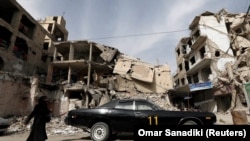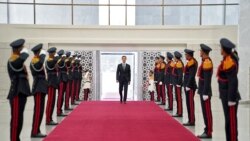On January 3, Hezbollah’s secretary-general, Hassan Nasrallah, delivered a speech on Hezbollah’s al-Manar television marking the second anniversary of the assassination of Qasem Soleimani, commander of the Quds Force of Iran’s Islamic Revolutionary Guard Corps (IRGC).
In his speech, Nasrallah praised Soleimani as a defender and protector of peace in the region. He vowed that those responsible for killing Soleimani will get just punishment, and he said the withdrawal of U.S. troops from Iraq and Afghanistan is one consequence of the assassination.
Hezbollah’s chief claimed that all participants in the Syrian war – Islamic State, the al Qaida-affiliated group Nusrah Front, various Arab and other regional countries – are tools against Syria in the hands of the United States.
“The United States is responsible for the war in Syria,” Nasrallah said.
History says otherwise.
The war in Syria did not start as the war it is today. It developed amid a wave of pro-democracy movements that swept over several Arab countries in 2010 and 2011 and became known as the Arab Spring. In countries like Tunisia and Egypt, the protests overturned autocratic regimes. However, in countries like Libya, Yemen and Syria, the uprisings morphed into all-out combat.
The protests in Syria began in March 2011 in the southern city of Deraa, then governed by President Bashar al-Assad’s cousin, in response to the arrest of teenage boys who had painted anti-Assad graffiti on the wall of their school. The boys were confined for weeks and tortured by Syrian government security forces.
The protests spread from Deraa to other Syrian towns and cities. Security forces fired teargas at protesters who began demonstrating regularly, and tanks and armed troops were deployed on the streets of cities across the country to preemptively quell the protests.
Faced with a violent response by the Assad government, opposition supporters took up arms to protect themselves and end government security forces’ control over their areas. Armed rebel groups emerged across Syria.
Despite regional and international calls for the Assad government to cease its crackdown on protesters, Damascus continued to use harsh tactics.
The Assad government promised reforms, but its brutality contradicted these promises. The regime claimed from the beginning that the violence was the result of a “conspiracy,” and “foreign backed terrorism.”
In his first speech following the start of the protests, Assad said that Syria’s “enemies” were “working every day” to undermine its security and stability. Assad said that there would be reforms, but that they would not come quickly because people's livelihoods needed to be taken care of first.
Assad did lift a 48-year emergency law, a key demand by protesters to abolish state security courts and allow free demonstrations. But the move was dismissed by oppositions groups as meaningless.
He also vowed to crush the “conspiracy” against the country, which he said had started in Deraa, near Syria’s border with Jordan.
Foreign powers – including Russia and the United States – eventually embroiled themselves in the fight between Syrian government forces and the rebels. Amid the growing chaos, the jihadist groups Islamic State (IS) and al-Qaida became involved when both moved to rebel-held Raqqa governorate in northeast Syria. In 2014, IS declared Raqqa city as its capital.
The Assad government used extreme violence to take back territory controlled by rebel groups. This included indiscriminate airstrikes and the use of chemical weapons – what rights groups and the United Nations later alleged were atrocities.
At least 1,400 people were reportedly killed in a 2013 chemical attack in Ghouta, outside Damascus. The Syrian Observatory for Human Rights, a monitoring group based in London, documented the names of 890 people killed in the Ghouta attack.
“Syrian government air strikes that have deliberately or indiscriminately killed civilians appear to be part of systematic and widespread attacks against the civilian population that Human Rights Watch previously found amount to crimes against humanity,” Human Rights Watch (HRW) wrote in an April 2013 report.
As officers defected from Syria’s army and security forces, Assad welcomed proxy fighters from Lebanese Hezbollah and Iran to support his fight against rebel groups.
In 2014, the then-U.S. President Barak Obama ordered airstrikes while working with the international and local partners in Syria, including the Kurdish-led Syrian Democratic Forces (SDF), to defeat IS. In a timeline published in 2019, the Associated Press reported that the U.S. had launched 17,000 airstrikes in Syria.
The U.S.-backed coalition achieved the defeat of IS, but a group of 900 U.S. troops remains in Syria to continue supporting the SDF in deterring a resurgence of IS.
The U.S. has also faced criticism for killing civilians in airstrikes, including a March 2019 attack targeting IS in Baghuz in eastern Syria that reportedly killed 80 civilians.
In March 2021, the Syrian war entered its 10th year.
The Syrian Network for Human Rights says it documented 228,099 people killed in Syria between 2011 and 2021. Of those, 200,000 were killed by the Syrian government and allied militias, 6,910 by Russian airstrikes, 5,083 by IS, 4,183 by armed rebels and 3,047 by the U.S.-backed multinational coalition.
In September 2021, United Nations High Commissioner for Human Rights Michelle Bachelet reported that the Syrian war had left more than 350,200 people dead but noted that this number was an “under-count of the actual number of killings.”
The U.N.’s refugee agency says more than half of the Syrian population remains displaced, with 6.6 million refugees in neighboring countries and 6.7 million displaced inside Syria.
In its most recent annual report, HRW said the Syrian government continues to restrict the delivery of humanitarian aid in government-held areas. It said the government “selectively approved aid projects to punish civilians in anti-government held areas and required humanitarian groups to partner with security-vetted local actors.”
Syrian security forces continue to arbitrarily detain and torture civilians. According to HRW, 100,000 people in Syria have disappeared.
In April 2020, a landmark trial began in Koblenz, Germany against two former Syrian intelligence officials accused of committing crimes against humanity. One of them, Anwar Raslan, allegedly oversaw the torture of 4,000 people.






